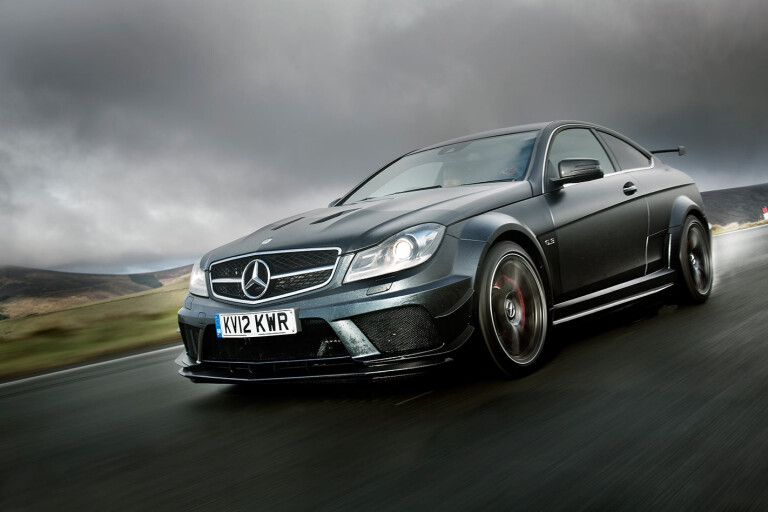
I HAVE seen the walls, and I can barely comprehend how the motorcycles average 213km/h for an entire lap, let alone nudge 300km/h through here.
This is a town, with hedgerows and houses lining the road. And the English build their houses very, very close to the road. It has telegraph poles and gutters and intersections, yet the bikes hit 300 on this downhill stretch, threading the needle through town at an astonishing 90 metres per second.
I have touched the walls, and they do not yield. They’re made of big bluestone rocks, piled one on top of the other, some jutting, some sharp. The riders come through here fully cranked, leaning hard into the bends, tearing their leathers as they brush the bluestone bricks with their knees. Apexing, it’s called.
I’m sitting on the wall, an AMG C63 Black parked nearby, trying to imagine what it must feel like for the mad motorcyclists, these Isle of Man TT competitors.
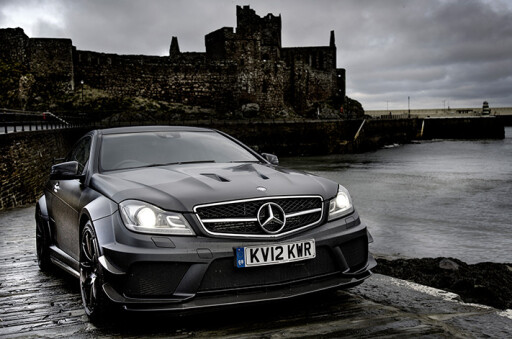
Surreal, like a speeded up computer game perhaps? But with all too real consequences if they get it wrong. And many do.
The Isle of Man TT is the deadliest motorsport event in the world. It has claimed 245 competitors since it began in 1907. Not to mention the countless brave (and crazy) enthusiasts who have died on Mad Sunday, when the track is opened to the motorcycling public. Compare that to the Nurburgring’s death toll (68), Indianapolis (56) and even Dakar (45) and you begin to understand the courage it takes to compete here.
I set myself a challenge. I want to experience what these insane bikers do. I want to feel the rush and feed off the adrenalin as the world whips by at a frightening velocity. But it’s not June, so it’s not race week. There are speed limits through the towns dotted around the 60.7km Snaefell Mountain Course that pretty much laps the Isle of Man. Outside those towns, however, there are no speed limits. In the mountains between Ramsey and Douglas there are never any speed limits, and very few cars. God bless the Isle of Man.
But I’m not on a race bike, and the road is not closed, so it would be madness to chase 300. Instead, I set myself the challenge to hit – and sustain, at least for a while – 213km/h. That’s the lap record average set in 2014 by Kiwi Bruce Anstey. By comparison, Greg Murphy’s Bathurst lap record average is only 176.
Heading out of town at 50km/h, the Black’s V8 barely off idle, I can’t stop thinking about two-wheeled rockets pounding down this concrete and bluestone chute at maximum attack, their riders protected by nothing more than a thin leather skin. For them, death waits behind a missed gear or a misjudged braking point. And, just in case they forget, there’s a cemetery right beside the startline.
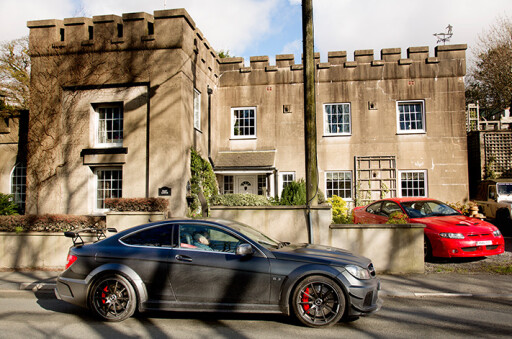
Melbourne plumber Cam Donald has contested seven Isle of Man TTs for two wins. He spearheads Norton’s high-profile assault on the 2015 event, to be held as this issue of Wheels went to print.
“I see the TT as a numbers game. If you keep coming back, sooner or later it’s going to catch you out,” he says. But he wouldn’t have it any other way: “Everyone that races here knows the dangers and they accept them, and they ride accordingly. I think it’s sad that we’re all wrapped in cotton wool these days and there are so few opportunities to do anything dangerous.”
Bridget Dobbs knows the toll better than most. Her husband, New Zealander Paul Dobbs, died here in 2010. “You can’t possibly ban it,” Bridget said when interviewed for TT documentary Closer to the Edge. “It’s like a monster; it’s bigger than the rest of us. People have said you only really know you’re alive when you’re so close to death … We love those photos of riders’ heads so close to the stone walls. The reason we love them is because they’re so astonishing.”
On the approach to the Gooseneck section outside Ramsey, a bluestone wall bulges alarmingly, the weight of a mountain distending it like a huge, angry pimple. But instead of re-profiling the wall to ensure riders don’t have their heads ripped off, organisers just painted the bulge white.
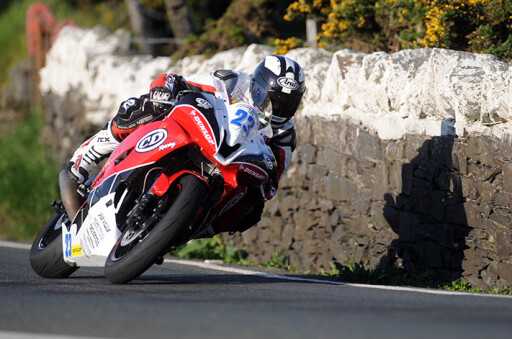
The circuit’s run up the western side of the island ends at the Ballaugh Pub. It’s right next to a small but steep billy-goat bridge into town, so steep the C63 gets a little airborne crossing it at 60km/h. Racing motorcycles get very airborne. The pub has closed-circuit TV inside, its camera trained on the bridge all year round so punters don’t have to stop drinking to watch the aerobatics.
Publican David Haigh was working the bar during the 2014 race when one rider’s brake disc exploded as he was slowing down from 260km/h. Instead of taking the dogleg at 80 or so with a crowd-pleasing jump, Bob Price launched off the bridge at close to 200 and straight into the side of the pub. Price’s bike hit the crash mats that cover the first floor of the pub’s wall, but he didn’t. His helmet impacted with the concrete above the protective mats. At that speed, the helmet couldn’t save him.
“It sounded like a bomb going off,” Haigh told Wheels. “He didn’t stand a chance. I’ve never sworn like I did when I come out from behind the bar. I looked right out this window to see what happened, and there’s this helmeted head staring back at me. And that was it. That was him. Gone.”
After Ballaugh, the tree-lined road undulates through typical farming land across to Ramsey. Through here it’s all about maintaining speed and staying on the racing line. Get it slightly wrong in one sweeper and you’re off-line for the next. If you’re lucky, you’ll only get overtaken by the bloke behind. If not, you’ll get up close with nature, fast.
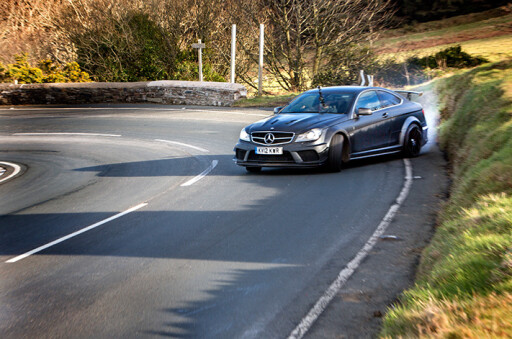
After Ramsey is the Gooseneck, and the climb up onto the mountain. As its name suggests, the Gooseneck kinks left before hooking hard right. It’s the second-slowest corner on the track after the Ramsey Hairpin, and a good place to unleash the C63’s playful side. We did four or five runs, sliding those fat rear Continentals, not including the first aborted run, which almost ended in a head-on with an overly ambitious motorcycle pilgrim. He outbraked himself badly, coming to a wide-eyed stop right in front of the C63’s rumbling snout. Lucky for me – and the biker – I had a lookout with a radio.
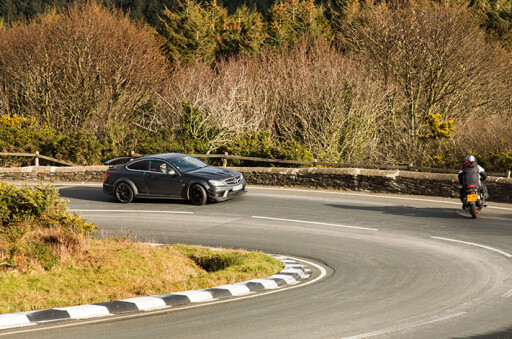
It’s on the mountain where the bikes sustain high velocities the longest, spending the best part of 20km between 250 and 300km/h. Watching two riders dicing on this insanely fast, flowing section is mesmerising. It’s so fast the TV helicopters struggle to keep up.
Up here, there’s a monument to the TT’s favourite son, 26-time winner Joey Dunlop. The Isle of Man TT didn’t kill Dunlop. A road race in Estonia did, in 2000. We stop to pay our respects, but don’t linger long because the wind is blowing harder. The temperature drops to zero. I jump back into the Black’s heavily bolstered racing seats and quickly realise we have a problem. We’re bogged. On grass.
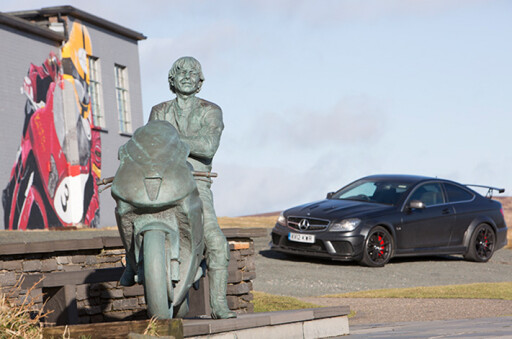
Arriving at the Joey Dunlop Statue, I’d parked the Black on a slight decline leading to a long drop, thinking the photographer might want to capture the impressive mountain vista. So it’s his fault the Black’s now bogged, its semi-slicks finding no traction on the spongy, wet grass. Every light prod of the throttle spins the rears, and the car slides forward a little closer to the long drop.
A headline plays in my mind: Museum machine plummets off mountain. Editor also plummets, moments later.
Two long planks of wood are scrounged, the photographer and I push on the Black’s nose, and our camera car driver presses the throttle gently. The car inches back from oblivion, onto solid ground. The irony is not lost on me that my brush with mortality should come at little more than walking pace. But it doesn’t slow me once back on the road.
At 200km/h we’re only covering 60 metres every second. The C63 is bellowing as only a naturally aspirated V8 beast can, gulping great lungfuls of bitterly freezing air and screaming like an angry dragon. My attention should be solely on the road, but it’s not; I’m watching the speedo, too. I want to see 213.
This road would be barely a country B-road in Australia; one lane each way, winding and climbing through a haunting and desolate green and brown patchwork. Nothing taller than tundra grass stands on the surrounding hills against this howling winter wind. There are no towns up here. The only sign of mankind is this cold and narrow strip of tarmac.

Today there are no motorbikes on the road, probably because it’s the middle of winter, and nor are there many cars. There’s one up ahead now, and I may have enough room to overtake without backing off before the road disappears around the next outcropping. I flick the indicator and floor the throttle. The V8 roars louder as the Black lunges. At this speed gentle bends have real menace. Left-right sweepers are treacherous combos waiting to lure you off-line and into the valley far below.
The Black’s doing the best it can, its wickedly enhanced aero and R-spec rubber keeping things planted. This hardcore C63 – a stripper super-coupe whose manners and good sense have been lobotomised to unleash the full maniac within – is tailor-made for this kind of driving. There’s no doubt it’s got the performance bandwidth to go harder on these roads. It’s the driver whose courage is on the limiter.
This pilgrimage to the Isle of Man was meant to be a fond farewell to one of the greatest examples of Benz’s brilliant 6.2-litre naturally aspirated V8 engine. You know, the demise of a legendary donk celebrated at a circuit synonymous with death.
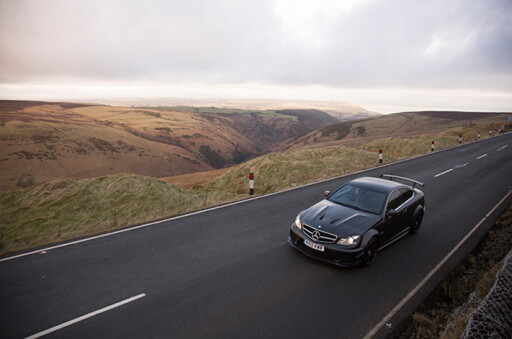
One last fang for an icon before it’s killed by a newer, harder, faster, more eco-friendly – and turbocharged – V8 in the next-generation C63.
Right now, the Grim Reaper would struggle to keep up. I’m determined to sustain the magical 213km/h, but every time I get there a corner nears and I’m forced to lift. The racing riders have it easier. They use the whole road, and there’s no oncoming traffic. But a bike’s total rubber footprint wouldn’t equal one of the massive tyres on each of the C63 Black’s four corners.
And if those leather-clad lunatics come a-cropper, they’ll have plenty of time to regret as the valley floor rushes up and flattens them. Just ask local ace Conor Cummins, born just down the road in Douglas, who in 2010 lost control and flew 60 metres before bouncing another 20 metres over a wall. He didn’t hit the wall, otherwise his injuries – broken back in two places, fractured left arm and pelvis, dislocated knee – could have been serious.

The C63’s matt-black metal shell gives me a sense of security. Still, as speed increases, so do the consequences. And this car’s worth $245,000. Well, it was in 2012-13 when it was actually available. The limited-run production life is long over. This particular example was liberated from the official Benz Heritage collection at Brooklands. It really is a museum piece.
The descent into Douglas is the end of the lap, and the end of my time at the Isle of Man. It’s also the end of my time in a C63 Black, the last time I’ll get behind this brutal and bellicose V8 engine. The end must not come with a whimper. I’m still on a mission.
The C63 Black screams up through the gears again, then a bend approaches and I’m on the brakes. Full throttle again, engine roaring. 200. 210. 220. Brake. 160. 170. 180. Brake. It’s futile. I abandon this folly and focus instead on my last few kilometres in a C63 Black.
Few cars could do justice to a lap of the Isle of Man TT course, even fewer would pay visceral respect to the motorcycles that strafe this isle every June.
The C63 Black’s slightly unhinged abilities and unfettered exuberance do both, and brilliantly. It’s loud, it’s brash and it’s blindingly quick.
And now it’s gone forever.
This article was first published in the July 2015 edition of Wheels Magazine.

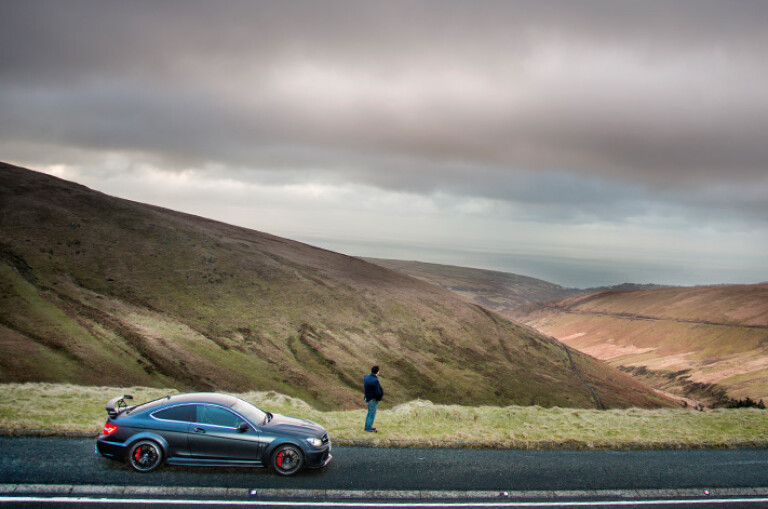
COMMENTS